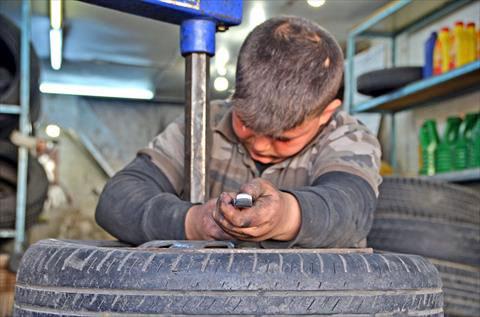You are here
‘22 per cent of children employed in agriculture sector sustained injuries’
By Hana Namrouqa - Jun 09,2014 - Last updated at Jun 09,2014
AMMAN — Nearly a quarter of the children employed in the agriculture sector in Mafraq and the Jordan Valley sustained work-related injuries, according to a report released on Monday.
The Report on Child Labour in the Agricultural Sector in Mafraq and the Jordan Valley (Jordanian and Syrian Working Children) indicated that around 22 per cent of these children were injured while working, 4.8 per cent of whom can no longer work as a result, while 36.9 per cent needed medical treatment but were discharged immediately.
“More injuries were reported in Mafraq than in the Jordan Vally — 13.5 per cent compared to 8.7 per cent respectively. Syrian children reported more injuries than Jordanians,” said the report, issued by the International Labour Organisation (ILO).
The report conducted a rapid assessment of Jordanian and Syrian children working in the sector, with the aim of determining the nature, pattern, distribution, dynamics and causes of child labour in agriculture, according to the ILO.
A total of 215 households were surveyed — 48.8 per cent Jordanian and 51.2 per cent Syrian — comprising 215 parents and 368 children, 170 of them Jordanian, with a larger representation of working boys and their fathers, according to the report.
“If you are a working child, you are more likely to feel exhausted, tired and be exposed to more health risks and injuries… More than half of the working children stated that they are highly exhausted by work,” the report indicated.
The study also revealed that 30.4 per cent of the surveyed children attended school, while the percentage of working Syrian children (51 per cent) was more than double that of Jordanians (18 per cent).
“The highest percentage of working children was for those between the ages 12 and 17 years at 82 per cent, split almost equal between Jordanian and Syrian children.”
The report’s authors said field work did not find clear evidence of the worst form of child labour in the agriculture sector, but some of the participants in the Jordan Valley noted that some children could be exposed to pesticides or other hazardous chemicals.
The report called for implementing programmes that tackle the pressing issue of child labour, especially in light of the added challenges facing Syrian refugee children.
“It is recommended that addressing child labour should be a key component of services provided by international and local NGOs to families and children in need, and to focus on providing working children with access to learning, psychosocial support and strengthening social cohesion,” the report said.
It also called for engaging the private sector, especially farmers and trade unions, in combating child labour, underscoring that advocacy efforts are almost nonexistent.
ILO Regional Deputy Director for Arab States Frank Hagman said child labour has been decreasing around the world over the past few years, but this is not the case in Jordan.
“There is mounting evidence that child labour has been increasing in Jordan over the past two years,” he added, noting that although the Syrian crisis has exacerbated the situation, it is not the main cause.
Calling on the government, and international and local NGOs to tackle the root cause of child labour, Hagman said it harms development in any country and undermines its social fabric.
Related Articles
AMMAN — On the World Day Against Child Labour, UNICEF, International Labour Organisation (ILO), Food and Agriculture Organisation (FAO) and
AMMAN — The International Labour Organisation (ILO) signed a project agreement with the Government of Australia, which aims to improve worki
AMMAN — On the occasion of the World Anti-Child Labour Day on Wednesday, the Labour Ministry on Tuesday announced that it has dealt with 197














